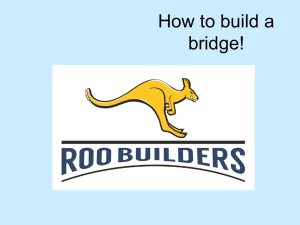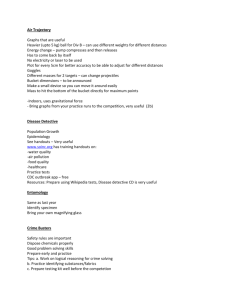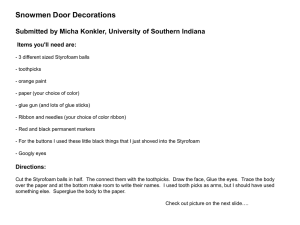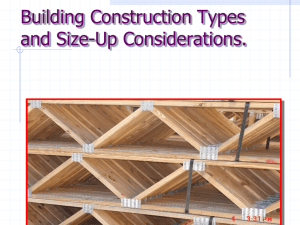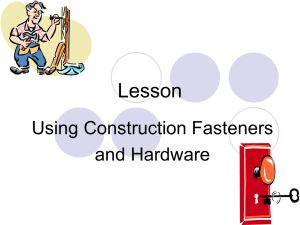How to build a bridge
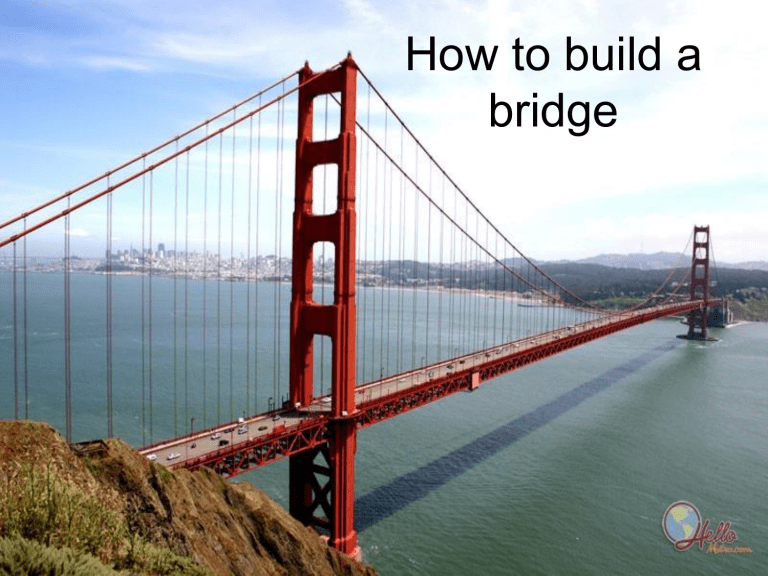
How to build a bridge
The Romans frequently built bridges with several small arches on top of one another.
This slideshow contains tips, hints and several interesting bridge designs.
You may use what you like. I will post this on my website for you to view later.
Tools and Equipment
• Not all of this is necessary, but all of it is very helpful.
“One only needs two tools in life: WD-40 to make things go, and duct tape to make them stop.”
-G. Weilacher
What glue should you use?
• Most glue is stronger than the wood itself
• As long as you use glue for what is was designed it might not really matter
• Different glues do have different advantages…
CA Glue (aka superglue)
• Dries quickly
• Very strong
• Don’t get cheap superglue
• Comes off your fingers naturally within two weeks
• Accelerators available
• Must use in a ventilated area
Excellent for gluing two sides together!
Titebond (I,II and III)
•Good brand of wood glue
•Three types available
•Clamp for ½ hour
•Water clean up
•Excellent for laminating beams together
Gorilla Glue
•Claimed to be very strong
•Expands while drying
•Takes 24 hours to dry
•Longer set time
•I wouldn’t use it.
Epoxy – the mother of all glues!
•Incredibly strong
•Relatively heavy
•Difficult to work with
•Available with different working times
•Skin contact is bad
•Good for laminating sticks together
Tools
•All of these tools are recommended.
•Scissors, ruler, square, level, and sharp blades
More tools
•Binder clips make excellent clamps (and are cheap)
•You need a sanding block and plenty of sandpaper.
Even more tools…
• Files will help you to shape the wood.
• Pins are available at hobby stores.
You must have many.
A 3/32” square file is particularly helpful in making notched joints.
You may need an assistant!
For playing with knives…
•This is a ceiling tile that has been glued to a thin piece of wood.
•The wood keeps it level and prevents pins from pushing through.
• A ceiling tile works very well to build on. It provides a level surface that you can pin into.
• Alternatively, you can use several sheets of cardboard stacked together.
How To Build Your Bridge
Planning
• Planning is good!
• I will provide a full scale template
• Use a ruler and make your plan full scale and symmetric
• Glue sticks together to make an actualsize ruler – two thick, three thick, etc.
• Tape your full scale plans to the board and pin a piece of wax paper on top. Plan templates are available from me.
• The wax paper prevents the glue from ruining your plans.
I buy 20 sticks.
You buy more if you need it.
I have more for sale!
• Glued joints will be stronger if you pre-sand all of the wood.
• Choose the best pieces of wood.
• Darker wood tends to be brittle but stronger.
Balsa Wood
Bass Wood
• Don’t get the wrong wood!
• Balsa is much less dense and scratches much easier.
• The bins at local suppliers are often mixed up.
Construction
• Take care to make good joints.
• When you are done, sand the heck out of it!
• Extra glue adds weight, but not strength.
• Make sure to follow the gluing directions!
• Take your time!
• I made all of the beams first
• Each beam is clamped with binder clips
• Alternate the clips so that the beam does not warp
• I used Titebond III for the beams
• Sand each beam until it is flat after it dries
• Make each side one at a time
• I used CA glue to glue in the cross braces
• The aluminum rods are available at any hardware store
• Don’t pin through the wood!
• Complete each side and then remove it from the wax paper
• Leave the pins in place for the second side to insure that they are identical
• Put the sides together and cross brace them
•Sand the entire bridge!
•Insert gussets where needed
Baking Your Bridge!
• You can loose A
LOT of water mass by baking your bridge!
• Low setting for about 15 minutes
• Seal in a plastic bag after baking
Bake at your own risk!
Bending Wood
• To bend wood, soften it first over boiling water.
• Steam softens wood.
• Bend, pin in place and let it dry.
• After dry, glue it
Never pin through the wood!
Truss Designs
Howe Truss
K Truss
Warren Truss
Pratt Truss
Types of Joints
Gussets improve a joint
End joint
(weak)
Lap Joint
(best)
Notched Joint
(better)
Interesting Designs
Arch
Elevated Beam
Scissor Truss
Loading your bridge
• This year, we will load each bridge with a 40 mm square steel plate that is 10 mm thick.
• The plate is attached to a 3/8” steel rod.
• We will load the bridge in one of three places
– the center or 50 mm on either side.
• The load point will be chosen randomly.
• You will load the bridge until it fails.
• Highest efficiency wins.
Good Luck!
• Bridges are rated on efficiency.
• Your bridge needs to be light and strong!
• The top five students at MVHS will go on to the regional competition in Bellingham.
• The top two in Bellingham will go to the
National Competition in Chicago.
• The winner at the international contest will be awarded a half-time scholarship to the
Illinois Institute of Technology!
